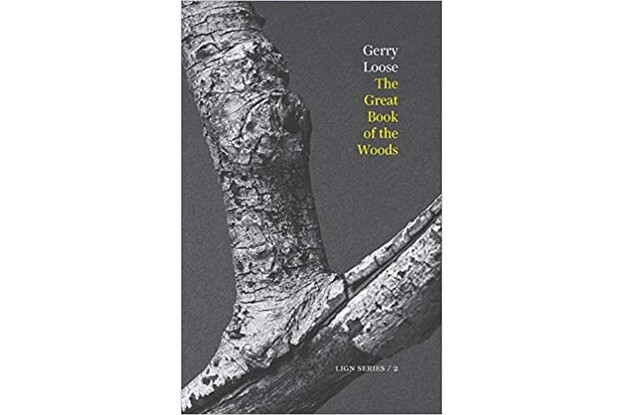Gerry Loose
from 'The Great Book of the Woods': 'Palimpsests & Riddles' (after the Ogham)

[From the edition newly published by Xylem Books, an imprint of Corbel Stone Press, 2020. See the author’s note below for more on Loose’s engagement with the ancient Ogham runes.]
Knockshanawee souterrain
a trick of the neck
is yew to pine
a trick of lungs
is pine to alder
a ruse of the voice track
is alder to yew
a trick of love
is brother to brother
a trick of darklight divine
is twin to twin
Knockshanawee souterrain riddle
it is cold
is there frost
there are thorns
are they pricking
there is a resolution
is it legion
there is clamour
is there silence
the wood is ancient
is it withered
there are crypts
is it an effort
Ballyknock short discourse
right to the marrow
flame & steel
elegant & forthright
oldest & coldest
felloe & tang
vanguard & bevy
pine & groan
swaddle & mass grave
Ballyknock riddle
sing us thorn
cleave us friend
not complaint
not rebuttal
soothe us horse
smooth us work
not effort
in soil
shelter us hind
sing us strength
flesh & grass
twining
Ballyknock letters swimming
hazel & pine then oak
start with these
their twists & torques
sisters to birch
they are the red boast
of sibling women
calling & scolding
sparks from speckled fire
Ballyknock from the lungs
the ash field
the oldest energy
the path of the voice
iron rod of breath
the driving of slaves
a proverb of slaughter
one third wheel
one third weapon
begin your answer, pine
call your nut-marrow, hazel
Ballyknock riddle
what thorn
& who’s a friend of lesion
what work is smooth
& who helps geldings
what guards
& who spills
what is simplicity
& who delights in kine
what lives cold
& who cultivates plants
what pain
& who replies
Cloghane Carhane
was she a friend
women fight
here among the ivy
now I begin to see lust
in the ivy
women fighting
bees swarming
now we’re all angry
should be
taking stock
minding cattle
was she a friend
thief of the grove of silence
lust
drains blood
boils my blood
was she a friend
Cloghane Carhane
underneath his name
carpenter’s work
it starts to make sense
hazel
it starts to make sense
alder
the most withered wood
the job in hand
clarity
cutting
the highest of bushes
ivy
nettles
the most decayed wood
it answers muster
the elm
the apple
forest & orchard
& the hazel
Abernethy
coltsfoot the apple that suckles
sun hoof the vine that strangles
sun horse the yew that sickens
Abernethy
quick gentle
so hard to quell
elder
the hind the hunt
quenched
elder
Church of the 3 Holy Brethren
Lochgoilhead
little saint of whitethorn
little douser of wolf spark
welcome to the burial mounds
dear confessor of blood-red berries
sweet dweller of beehive cell
oaks make good gallow-trees
my heart
meagre
Church of the 3 Holy Brethren
Lochgoilhead
bees have their own pollen auguries
there are thirteen
of blanching night
of swarming death
of chilling earth
of propagating plants
of lustrous herb
of the infirmity of tone
& six contained
in the thicket of letters
AUTHOR’S NOTE. Ogham is a rune-like script of the early Irish language found on standing stones made between the fourth and eighth centuries CE. It comprises strokes across or to either side of a central stem line. Each stroke now represents a letter of the Gaelic Beith-luis-nin “alphabet.” It is found on monoliths mainly in Ireland, with some in Scotland, and some dual-text ogham/Latin stones in Wales. There are also inscriptions other than the monolithic — on tools or in caves — but these are rare.
There are numerous myths concerning the script’s origins: that it was invented to keep secrets from the Roman conquerors of nearby Britain; that it was similarly invented to keep secrets from the lands that Ireland was later to annexe as Dal Riada (the islands and mainland of western Scotland); that it was invented by an obscure fourth-century CE Christian sect. It is also said in some quarters that it was handed down by, or named for, Ogmos, the Celtic god of eloquence.
There are many methods of interpreting ogham. The script itself is steeped in the secrecy of the literate over the nonliterate. It is therefore always regarded as the property of the high poets, the early medieval fili of Ireland, who would spend many years memorizing up to fifty ways of reading or deciphering it. The poetic possibilities are therefore manifold.
. . . . . . .
The poems here are therefore versions, creative reinventions and cocreations, made with other poets and translators who lived from the fourth to the fourteenth centuries CE.
[N.B. Much more of this commentary is included in Loose’s very useful introduction to his book, and additional excerpts can be found elsewhere on Poems and Poetics. (j.r.)]
Poems and poetics